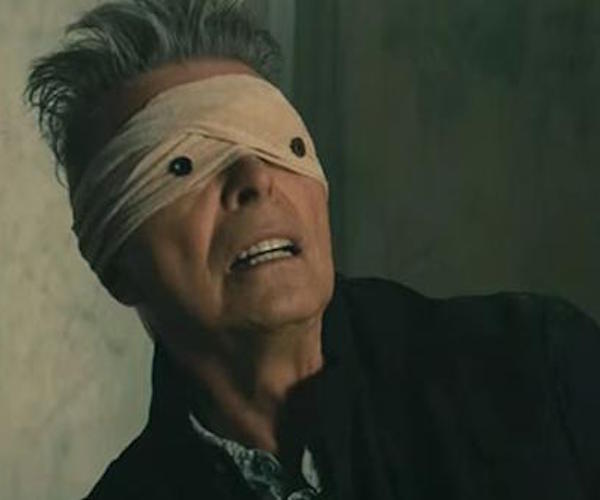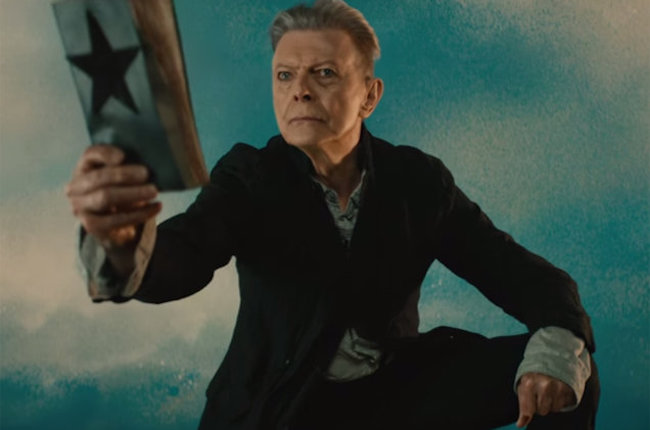WATCH CLOSELY: “The Last Five Years” — David Bowie’s Immortal Artistic Vision
To the end of his life, David Bowie was excited about creating innovative sounds and collaborating with new musicians.

David Bowie in the video for “Lazarus.”
By Peg Aloi
David Bowie. How best to describe this iconic artist? His music influenced other artists and helped define genres. His theatrical performance style and elaborate costumes defined several decades of creative output, a fascinating parade of oddball personae, characters who inhabited Bowie’s songs and took their place in a firmament all his own — the Starman who conjured a unique universe. Many fans are still gazing at the sky, bereft, still struggling to comprehend the star’s enigmatic genius at the second anniversary of his death on January 10, 2016, just two days after his 69th birthday and two days after the release of his final album, an untitled work now known as “Blackstar” because of the image shown repeatedly in its artwork and video imagery.
Now showing on HBO (network and streaming on HBO-Go), the BBC-produced documentary David Bowie: The Last Five Years explores the musician’s final artistic efforts in the years prior to his death. The film, at 95 minutes long, pays particular attention to the work that went into Blackstar, its haunting songs and brilliant videos a self-conscious swan song that Bowie crafted to say goodbye: to his fans, to his art, to the world.
The documentary opens with footage shot just after the news of Bowie’s death reached London, in Brixton, the south London neighborhood where Bowie was born David Jones in 1947. A large mural of Bowie’s face had been painted there by an artist a few years ago, and the film shows the street is filled with fans taking smartphone videos and photos of the mural, creating impromptu altars with flowers and candles. Given his prolific career, which spanned five decades, dozens of albums and a number of high profile film roles, it’s fair to say that Bowie’s most impassioned fans would have to be obsessed to maintain familiarity with all of the artist’s catalog. And indeed, some followers know every lyric and every nuance of every costumed personae.
But the marvelous thing about Bowie was his constant need for reinvention, which reinvigorated his art. For every fan whose favorite albums were recorded before 1977, there are those who first started listening with the release of Let’s Dance in 1983. For every filmgoer who can’t get enough of The Man Who Fell to Earth (1976), or 1983’s The Hunger (that would be me), there’s someone who’s seen Labyrinth (1986) fifty times. But even with more than a dozen feature film roles to his credit, it was in music videos, an art form he more or less pioneered well before the birth of MTV, where Bowie explored the many permutations of the highly visual personae he created to dramatize his music.
The Last Five Years contains plenty of produced music video, but also a good deal of previously unseen concert footage, as well as some off-stage conversations and glimpses of unguarded moments. A fair amount of voice-over material from an interview (which sounds fairly recent) also provides astute commentary on Bowie’s career and artistic endeavors, as well as on topics such as stage fright (which initially inspired his tendency to create characters with elaborate costumes for performing his songs on stage). Bowie’s film career doesn’t get as much attention as I’d have liked but, when The Last Five Years details the process of making Blackstar, there’s plenty of compelling and dramatic content about the making of his videos and working with an eclectic assortment of mostly European directors. For those who are fascinated by the enigmas posed by these videos’ unusual imagery (such as the face bandages with small buttons for eyes, a haunting visual from “Lazarus”), this documentary will not disappoint.
There is also a fairly lengthy segment on the stage production of the musical Lazarus, a sort of continuation of the narrative threads in The Man Who Fell to Earth, Space Oddity, etc. The lead character and Major Tom/Bowie stand-in is played by the excellent Michael C. Hall, the star of Dexter and Six Feet Under, both series that deal consistently and profoundly with death and dying. The production is very minimal, focused on the intimate quality of the performance. Hall, a gifted and sensitive actor, seems perfect for the part. The play was still in production as Bowie was battling cancer; he died just after its premiere in January 2016.

An image from David Bowie’s album “Blackstar” featured in “The Last Five Years.”
Some of the most moving and, indeed, sad content of The Last Five Years occurs near its conclusion, when it is becomes apparent that Bowie is trying desperately to complete his last album as well as the two videos made to accompany it. The video for the song “Blackstar” was completed in 2015; “Lazarus” was completed in 2016. A year prior, in 2014, Bowie worked on David Lynch’s Twin Peaks: The Return, reprising, albeit in an unusual form, his role of Phillip Jeffries. The impressive intensity of this period of work is made all the more poignant by the fact that Bowie had gone more or less on an artistic hiatus from writing music, beginning in 2005 and ending in 2013, when the video for a new single, “Where We Are Now ” was released. The film explores the song’s background (Bowie’s days living in Berlin in 1976 ) and visual clues, offering up commentary on his failed love affair with an English girl. Bowie’s creative process is looked at in a matter-of-fact context; it’s somewhat surprising to learn that there were times that the origins of his often esoteric-seeming lyrics and imagery are actually quite prosaic.
Blackstar is similarly confounding: inscrutable on its surface, but hauntingly familiar once you acclimate yourself to its eerie sounds and images. The lyrics seem to contain clues to a narrative that runs parallel to the songs themselves: a sort of meta-story Bowie seems to dare listeners to unravel. In “Lazarus,” for example:
“Look up here, I’m in heaven/
I’ve got scars that can’t be seen/
I’ve got drama, can’t be stolen/
Everybody knows me now.”
And, from “Blackstar”:
“Something happened on the day he died/
Spirit rose a metre then stepped aside/
Somebody else took his place, and bravely cried/
(I’m a blackstar, I’m a blackstar)”
The Last Five Years offers theories and musings on this last great work from a number of people, including band members, producers, and friends. To the end of his life, Bowie was excited about creating innovative sounds and collaborating with new musicians; the jazz stylings in Blackstar are as surprising as they are perfect. The commentators all seem to agree that the staying power of Bowie’s work, that which still speaks so deeply and clearly to so many, remains elusive, mysterious — and no one would wish it to be otherwise.
Peg Aloi is a former film critic for The Boston Phoenix. She taught film and TV studies for ten years at Emerson College, and currently teaches at SUNY New Paltz. Her reviews also appear regularly online for The Orlando Weekly, Cinemazine, and Diabolique. Her long-running media blog “The Witching Hour” can be found at themediawitch.com.
Tagged: David Bowie, David Bowie: The Last Five Years, documentary, HBO
